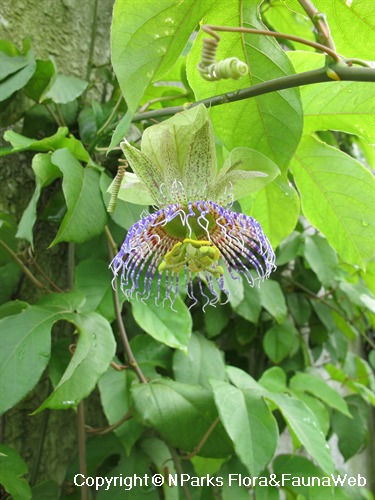
Back
Passiflora edulis (purple fruit)
| Family Name: | Passifloraceae |
| Common Name: | Passion Fruit, Granadilla, 百香果, 西蕃莲 |
Passiflora edulis (purple fruit), also known as the Passion Fruit, is a climbing vine that thrives in containers grown under full sun. Its Chinese name (百香果) roughly translates to "Fruit of a Hundred Fragrance" relating to its tart and sweet taste with hints of mango, oranges, and kiwi. This complex aroma makes it a popular flavour in desserts, yoghurts and beverages.
Name
Classifications and Characteristics
| Plant Division | Angiosperms (Flowering Seed Plants) |
|---|---|
| Plant Growth Form | Climber |
| Lifespan (in Singapore) | Perennial |
| Mode of Nutrition | Autotrophic |
| Maximum Height | 15 m |
Biogeography
| Native Distribution | Brazil to Northeastern Argentina |
|---|---|
| Native Habitat | Terrestrial |
| Preferred Climate Zone | Sub-Tropical / Monsoonal, Tropical |
| Local Conservation Status | Non-native |
Description and Ethnobotany
| Growth Form | Herbaceous perennial climber up to 15 m long. It has a lifespan of 5-7 years, but typically becomes less productive at 5 years. |
|---|---|
| Foliage | Tri-lobed, glossy leaves are light green to yellow-green (13 cm wide by 15 cm long) with toothed leaf edge. |
| Stems | The stems are approximately circular in cross-section. |
| Flowers | Solitary flower up to 7 cm wide is composed of white, oblong petals overlaid by white stringy filaments (up to 2.5 cm long) with dark purple bases. Each flower has 5 stamens (pollen-producing structures) and 3 styles (egg-bearing structures) which are beige and arranged radially. |
| Fruit | Round, oblong or egg-shaped fruits (4-5 cm wide) have a thick, smooth rind and contain edible, black seeds surrounded by sweet-sour, yellowish juicy pulp. While Passiflora edulis fruits come in a wide variety of colours (eg., yellow, red, purple), this record refers to the type with purple fruits. |
| Cultivation | Passion Fruit grows best in fertile, well-drained soil which is watered regularly. Quarterly feed with a fertiliser having a NPK ratio of 10:5:20. It grows best in full sun, but could use some shade from intense afternoon sun. The heavy stems need a strong trellis to support their weight. Regular pruning stimulates vigorous growth, but leave enough foliage to protect fruits from the hot sun. Apply a thick layer of mulch to protect the shallow root system. |
| Ethnobotanical Uses | Edible Plant Parts : Edible Fruits, Edible Seeds, Edible Leaves Food (Fruit or Vegetable): The fruit's juicy pulp is used to add flavour to various fruit drinks, jams and desserts. Flowers are used to prepare herbal tea, and leaves are consumed as a cooked vegetable. Medicinal: Fruit peel extract may be able to relieve symptoms of osteoarthritis and asthma, as well as lower blood pressure (Cordova et al 2013). |
Landscaping Features
| Desirable Plant Features | Ornamental Flowers |
|---|---|
| Landscape Uses | Trellis / Arbour / Pergola |
| Thematic Landscaping | Economic Garden |
Fauna, Pollination and Dispersal
| Fauna Pollination Dispersal Associated Fauna | Bee-Attracting |
|---|---|
| Pollination Method(s) | Abiotic (Self-Pollinated), Biotic (Fauna) (Insects (Bee), Associated with: Can be hand-pollinated.) |
Plant Care and Propagation
| Light Preference | Full Sun |
|---|---|
| Water Preference | Moderate Water |
| Plant Growth Rate | Fast |
| Rootzone Tolerance | Fertile Loamy Soils, Well-Drained Soils |
| Propagation Method | Seed, Stem Cutting, Grafting, Air-Layering |
| Propagation Method Remarks | Passion Fruit is usually propagated by seed. |
Foliar
| Foliage Retention | Evergreen |
|---|---|
| Mature Foliage Colour(s) | Green |
| Mature Foliage Texture(s) | Smooth, Glossy / Shiny |
| Foliar Modification | Foliar Tendril |
| Foliar Type | Simple / Unifoliate |
| Foliar Arrangement Along Stem | Alternate |
| Foliar Attachment to Stem | Petiolate |
| Foliar Shape(s) | Non-Palm Foliage (Palmate) |
| Foliar Venation | Palmate |
| Foliar Margin | Serrate / Toothed |
| Foliar Apex - Tip | Acute, Obtuse |
| Typical Foliar Area | Mesophyll ( 45cm2 - 182.25 cm2 ) |
Non - Foliar and Storage
| Stem Type & Modification | Herbaceous |
|---|---|
| Root Type | Underground (Fibrous Root) |
Floral (Angiosperm)
| Flower & Plant Sexuality | Bisexual Flowers |
| Flower Colour(s) | Purple, White |
|---|---|
| Flower Grouping | Solitary |
| Flower Location | Axillary |
| Flower Symmetry | Radial |
| Flowering Period | Free-Flowering |
| Flowering Opening Time | Time-Independent |
| Flower Lifespan on Plant | 1 Day |
| Flowering Habit | Polycarpic |
Fruit, Seed and Spore
| Mature Fruit Colour(s) | Purple |
|---|---|
| Fruit Classification | Simple Fruit |
| Fruit Type | Fleshy Fruit , Berry |
Image Repository
Others
| Master ID | 15543 |
|---|---|
| Species ID | 3332 |
| Flora Disclaimer | The information in this website has been compiled from reliable sources, such as reference works on medicinal plants. It is not a substitute for medical advice or treatment and NParks does not purport to provide any medical advice. Readers should always consult his/her physician before using or consuming a plant for medicinal purposes. |











